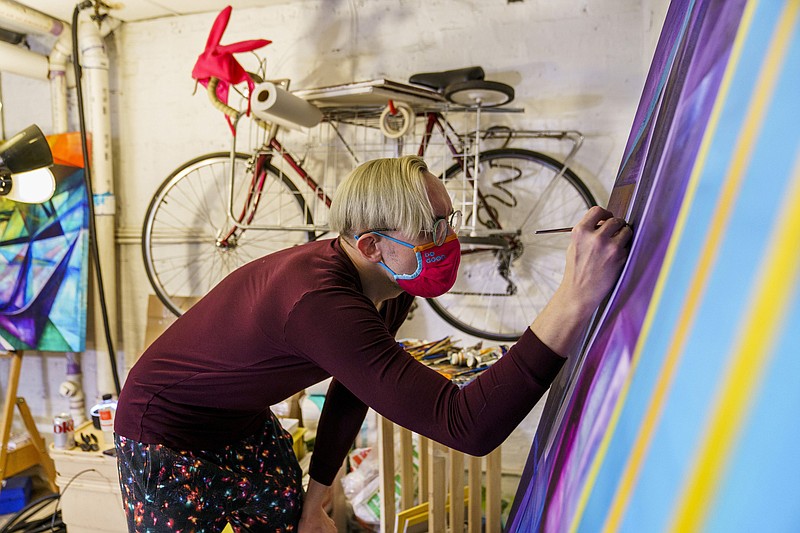CHICAGO -- Every morning, Dr. Justin Fiala rides a CTA bus along Lake Shore Drive, and it feels like going into battle. Before the pandemic, stepping onto a bus was just a commute to work. He and other Chicagoans headed into the city together, toward busy downtown offices and mask-free cubicles.
Now, he wears an N95, and his 5 a.m. bus rides are nearly always filled with other health care workers in scrubs.
"People look more and more downtrodden as the pandemic has trudged on," he said.
The scene from the back of a city bus is the focus of a canvas he's been painting lately, something Fiala describes as "almost like a love letter for those who are on the bus every single morning."
Since he was a child, Fiala has painted; when he was young, his parents enrolled him in regular classes at the Village Art School in Skokie. Art is something he kept steadily returning to, losing extra time for it temporarily as he went through college and residency.
During the pandemic, Fiala once again picked up paintbrushes. He would work one week in the intensive care unit, and have one week off.
"It was going from 120 miles (an hour) to zero," he said. "It was like, what am I supposed to do?"
He began using a room at home to work on oil paintings as a way to process what he was seeing as a pulmonary and critical care specialist at Northwestern. He and other health care workers have found using art can be a way to find mindfulness and a form of therapy.
A recent painting began as very abstract, triangles and planes. As brushstrokes formed, it became a type of self portrait.
He thought, "This must be what authors feel like when they say the characters write themselves." A face started to come in, and that face was joined by a breathing tube. The lines in the painting resemble, to him, the shape of hooks.
"It's like this patient is truly in limbo," he said. "They're stuck."
It reflects, to him, a nebulous barrier within the intensive care unit, "this place where people are half alive, and we're hoping we can tip them toward recovery, but so often they end up going the other direction."
Fiala's paintings include "Blue mask," featuring the ubiquitous protective gear, and "Ecmo patient," showing the tubes that worm into a patient's body on the life- support machine.
Last year, he donated a painting to the intensive care unit, dedicated to physicians, nurses, respiratory therapists and other staffers caring for COVID patients.
"I think what can be lost on the general public, a lot of them, is things can seem very normal outside of the hospital because you're not seeing the people who are sick. You hear about the surge going on, but you have nothing tangible to necessarily grab onto," he said.
For health care workers facing it upfront, nearly two years of a pandemic has created new layers of challenges and persistent feelings of burnout.
As a physician, Fiala feels he is lucky to have respites from the hardest floors. He has time off; he also works with rehabilitation patients, seeing the positive and uplifting side as patients get better. But the nurses in intensive care, for example, some of this "favorite people," remain there day after day. Decades of experience among them, they are the backbone of a unit constantly under pressure.
Recently, he worked during Christmas week. The downtrodden feeling was "palpable," he said.
Time after time, he's offering treatments he knows may not work. And he sees the toll they take on patients; helping a body breathe can require intense recovery if it even works. It's such a heavy toll he's considered whether he would want such a situation for himself. And that inevitably leads to ethical questions about why, then, they provide these to people's family members, patients who sometimes were not able to consent while conscious on their own.
"It creates all these ethical gray areas that if you're the person who has to decide, 'Are we going to do this or not,' it can leave you feeling pretty lousy," he said.
Even before the pandemic, his job was intense. He faced ethical quandaries. His patients died. But now, those moments come more often, and they arrive with added layers like patients who did not get vaccinated. Should one of these patients be more in line, for example, for a lung transplant? What about a smoker? These are questions that are woven into the daily practice for health care workers on the front lines of COVID-19.
Meanwhile, they continue to see refusals to wear masks and ebbing precaution guidelines.
So sometimes Fiala goes home, and he paints.
But this day was not for painting. Instead, he stepped onto the 5 a.m. bus to treat patients in a Northwestern clinic. Around 10 a.m., already at work for four hours, he was heading home for a nap before returning at 6 p.m. for an overnight shift.
Then, he would take the bus home at sunrise.

